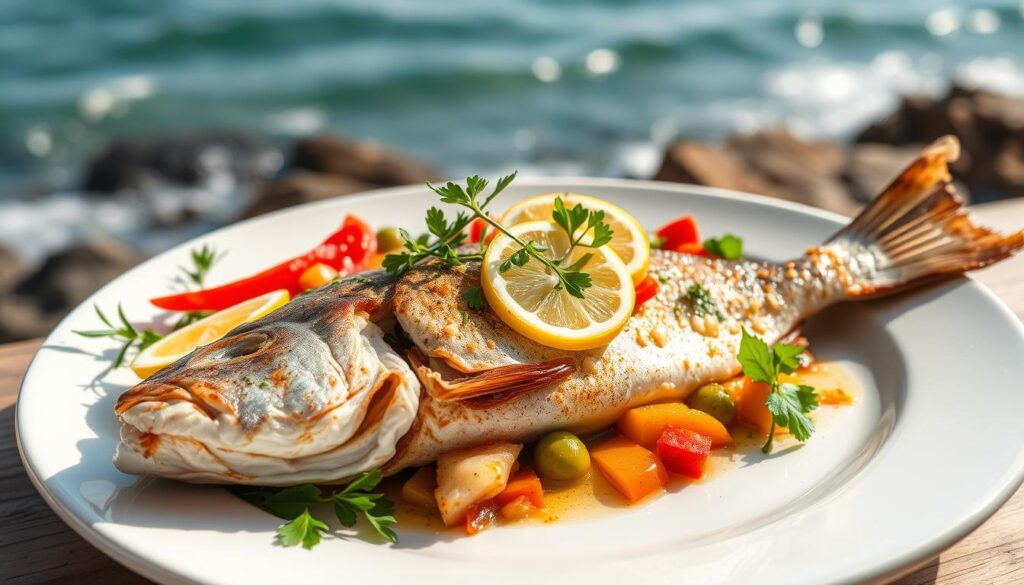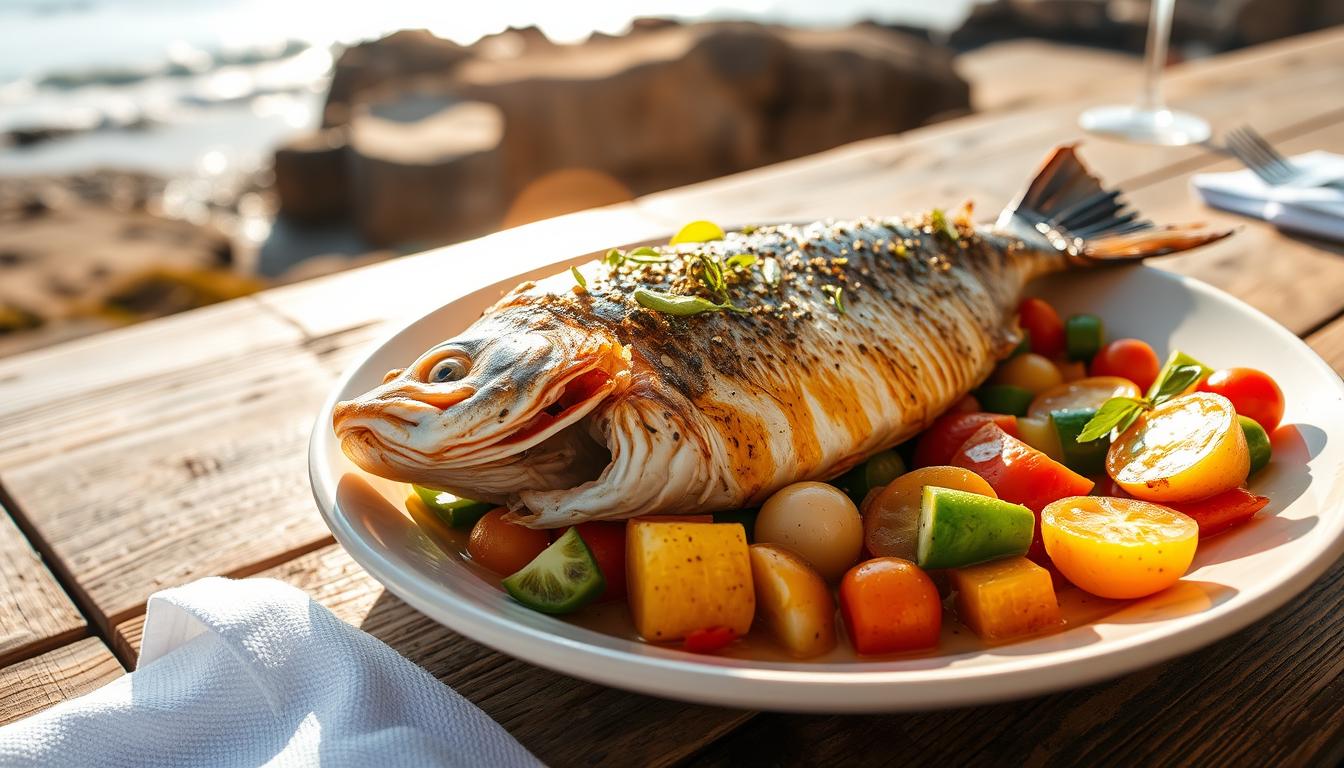This post contains affiliate links.
As the sun sets, the Mediterranean sky turns orange and pink. I remember my first time trying sea bass. The salty air, the sound of waves, and the excitement for a meal that changed my seafood view. This fish, called branzino in Italy, is now a favorite in my kitchen.
Mediterranean Sea Bass is more than a fish; it’s a link to coastal Europe and North Africa’s rich food traditions. It’s loved by chefs and home cooks for its versatility and mild taste. Whether you’re into sea bass fishing or Mediterranean seafood, it will impress your taste buds.
In Sicily’s fish markets and the French Riviera’s fancy restaurants, sea bass is a star. Its flaky flesh and sweet taste work well with many cooking styles. Let’s explore why this fish is so popular worldwide.
Key Takeaways
- Mediterranean Sea Bass, also known as branzino, is a prized white fish with a delicate flavor.
- It’s a versatile ingredient in Mediterranean cuisine, suitable for various cooking methods.
- Sea bass is rich in protein and low in fat, making it a healthy choice for seafood lovers.
- The fish can be prepared whole or filleted, offering flexibility in recipe creation.
- Sustainable fishing practices are crucial for preserving sea bass populations in the Mediterranean.
Introduction to Mediterranean Sea Bass
Mediterranean Sea Bass, known as Dicentrarchus labrax, is a favorite in coastal dishes. It lives in the Mediterranean Sea, Black Sea, and eastern Atlantic Ocean. Its mild flavor and tender texture make it a hit in Mediterranean cuisine.
What is Mediterranean Sea Bass?
Mediterranean Sea Bass is a fish loved for its taste and texture. It’s often grilled, baked, or pan-seared in Mediterranean dishes. The fish is also important in aquaculture, with over 180,000 tonnes produced in 2018.
Origin and Habitat
Also known as European Sea Bass, it comes from the northeastern Atlantic, Mediterranean, and Black Sea. It likes coastal waters and can live in different places, like estuaries and lagoons. Wild catches have ranged from 8,500 to 11,900 tonnes a year, with France catching the most in the Atlantic.
Popularity in Mediterranean Cuisine
Sea bass is a big deal in Mediterranean cooking. It’s loved by chefs and home cooks for its versatility. Countries like Greece, Turkey, Italy, Spain, Croatia, and Egypt are big producers. Turkey is the top producer, helping to deliver over 1 million fish meals worldwide.
| Characteristic | Value |
|---|---|
| Record Size | 10kg (France, 1999) |
| Typical Market Size (Wild) | 1-3kg |
| Global Wild Production | 10,000 tonnes |
| Global Farmed Production | 180,000 tonnes |
| Energy Content (per 100g) | 194kcal/810kj |
Despite its fame, wild sea bass numbers have dropped in European waters. This has led to fishing limits and worries about sustainability. Now, there’s more focus on catching fish responsibly and farming them sustainably to meet demand.
Nutritional Profile of Sea Bass

Sea bass is a top choice in the Mediterranean for its health benefits. It’s a lean fish with 20.6 grams of protein in every 3-ounce serving. It’s also low in calories, with just 124 per serving, making it great for weight management.
Sea bass is packed with nutrients. It has 0.5 grams of omega-3 fatty acids per serving. These fats are good for your heart and brain. It’s also a great source of vitamins and minerals. For example, it has 79% of the daily vitamin B12 and 25% of selenium, an antioxidant.
| Nutrient | Amount per 3 oz serving | % Daily Value |
|---|---|---|
| Calories | 124 | – |
| Protein | 20.6g | 41% |
| Total Fat | 4g | 5% |
| Omega-3 Fatty Acids | 0.5g | – |
| Vitamin B12 | 1.9µg | 79% |
| Selenium | 13.75µg | 25% |
Sea bass is almost carb-free, making it good for low-carb diets. It’s high in protein, which helps build and repair muscles. Its omega-3s may also lower inflammation and support heart health. Selenium in sea bass boosts the immune system.
However, sea bass does contain mercury. Pregnant women, nursing mothers, and young children should eat it in moderation. People with kidney issues should talk to a doctor because of its high potassium. Still, sea bass is a nutritious choice for most people in a balanced Mediterranean diet.
Fishing and Sustainability Practices
Sea bass fishing has changed to meet both tradition and conservation needs. Sustainable fishing practices aim to keep this fish safe for the future.
Traditional Fishing Methods
Anglers have used hook-and-line and netting to catch sea bass for a long time. These methods can harm wild populations if not controlled. Now, sea bass fishing blends old ways with new conservation methods.
Sea Bass Aquaculture
Fish farming is key in meeting sea bass demand. Practices like Recirculating Aquaculture Systems (RAS) and Integrated Multi-Trophic Aquaculture (IMTA) raise sea bass well. These methods help wild stocks and support marine conservation.
Conservation Efforts
Marine conservation works to protect wild sea bass. It includes fishing limits, size rules, and breeding areas. The Aquaculture Stewardship Council (ASC) checks farms for environmental and social standards, ensuring sea bass is raised right.
| Year | World Farmed Sea Bass Production (tonnes) | Value (USD billion) |
|---|---|---|
| 2003 | 60,000 | N/A |
| 2018 | 235,537 | 1.16 |
| 2030 (projected) | 305,000 | N/A |
As demand for sea bass grows, sustainable fishing and farming are more important. By mixing old fishing ways with new conservation, we can enjoy this fish and protect it for the future.
Culinary Uses of Mediterranean Sea Bass
Mediterranean sea bass is great in many saltwater fish recipes. It’s perfect for different cooking styles, making it a hit in Mediterranean dishes. Seafood importers have made it easy to find in the U.S., letting home cooks try new recipes.
Sea bass can be cooked whole, filleted, or in soups and stews. Its mild taste is loved by all ages. It goes well with Mediterranean herbs, garlic, and olive oil, making dishes tasty and healthy.

- Grilled whole with herbs and lemon
- Baked and stuffed with aromatics
- Pan-seared fillets with crispy skin
- Poached in broth for light soups
- Braised in tomato-based stews
Sea bass is not just tasty but also good for you. It has lots of omega-3 fatty acids, about 600mg per 100-gram fillet. It’s also packed with magnesium, potassium, and selenium.
| Nutrient | Amount per 100g |
|---|---|
| Omega-3 fatty acids | 600mg |
| Protein | 18g |
| Calories | 97 kcal |
| Vitamin D | 2.2 µg |
For a burst of Mediterranean taste, try a Greek-style sea bass recipe. Marinate the fish in garlic, lemon, and oregano. Then, bake it with zucchini and cherry tomatoes. This dish is simple yet elegant, highlighting the fish’s versatility and natural flavors.
Preparing Sea Bass: Tips and Techniques
Learning to prepare sea bass is key to mastering Mediterranean seafood. This guide will show you how to pick, clean, and cook this fish perfectly.
Selecting Fresh Sea Bass
When picking sea bass, look for bright eyes and shiny scales. It should smell mild and briny. For frozen, make sure it’s wild-caught and free of additives. White fillets should be firm and have a light pink color.
Cleaning and Filleting
To clean sea bass, remove scales and gut the fish. Filleting means making careful cuts along the backbone. If you’re new, ask your fishmonger to fillet it for you.
Ideal Cooking Methods
Sea bass is great in the kitchen. You can grill, bake, pan-sear, or steam it. It cooks fast, needing only 5-7 minutes per side. Don’t overcook it to keep it moist. The internal temperature should be 145°F.
Try this easy recipe: Pan-fry sea bass fillets in olive oil with garlic and lemon. Serve with roasted veggies for a quick Mediterranean meal. Remember, the right cooking techniques are crucial, so watch your timing and temperature.
| Cooking Method | Time | Temperature |
|---|---|---|
| Grilling | 5-7 minutes per side | Medium-high heat |
| Baking | 15-20 minutes total | 400°F |
| Pan-searing | 3-4 minutes per side | Medium heat |
With these tips, you’re set to make tasty sea bass dishes that highlight the best of Mediterranean cuisine.
Mediterranean Sea Bass
Mediterranean Sea Bass, also known as Branzino or European Bass, is a prized catch. It’s loved by anglers and food lovers alike. This fish is known for its high seafood quality and unique taste.
Distinctive Flavor Profile
The Mediterranean Sea Bass has a mild, sweet taste with a hint of nuttiness. Its delicate flavor is perfect for those who like less strong fish tastes. It goes well with Mediterranean ingredients like bay leaves, rosemary, and lemon, boosting its flavor.
Texture and Meat Quality
The texture of Mediterranean Sea Bass is exceptional. It has white, flaky flesh with few bones, making it easy to cook and eat. When cooked right, the meat stays moist and tender, with the skin getting crispy.
Sea bass is not just tasty but also healthy. A 100-gram fillet has about 600mg of EPA and DHA Omega-3 fatty acids, good for the heart. It has less Omega-3 than salmon but is rich in magnesium, potassium, and selenium.
| Characteristic | Description |
|---|---|
| Flavor | Mild, sweet with nutty undertones |
| Texture | White, flaky, moist when cooked |
| Omega-3 content (per 100g) | 600mg EPA and DHA |
| Cooking versatility | High (baking, grilling, frying) |
Whether you’re fishing in the Mediterranean or buying sea bass at the market, it’s a treat. Its quality and versatility make it a favorite among cooks and chefs.
Popular Sea Bass Recipes
Sea bass is a favorite in Mediterranean cuisine. It’s great for both simple and complex dishes. Its delicate flavor and texture make it a star.
Greek-style whole roasted branzino is a classic. It’s stuffed with lemon and herbs before roasting. Italian acqua pazza cooks sea bass in a tomato and white wine broth. Spanish lubina a la sal seals the fish in salt for baking.
Grilled sea bass with Mediterranean vegetables is light and tasty. It uses 2 pounds of fillets, grilled for 15 minutes. Leftovers can be stored for 3 days or frozen for 2 months.
Pan-seared sea bass fillets with herb butter sauce are quick and elegant. Cook thin pieces for 3-4 minutes on each side. A lemon garlic herb sauce adds flavor. White wine like pinot grigio or sauvignon blanc enhances the dish.
| Recipe | Cooking Method | Key Ingredients |
|---|---|---|
| Greek Roasted Branzino | Oven-roasted | Whole sea bass, lemon, herbs |
| Italian Acqua Pazza | Poached | Sea bass, tomatoes, white wine |
| Spanish Lubina a la Sal | Salt-crusted | Whole sea bass, sea salt |
| Grilled Sea Bass | Grilled | Sea bass fillets, Mediterranean vegetables |
| Pan-Seared Sea Bass | Pan-seared | Sea bass fillets, herb butter sauce |
Pairing Sea Bass with Mediterranean Flavors
The art of pairing food is especially beautiful with Mediterranean sea bass. This fish is perfect for Mediterranean cuisine because it takes on many flavors well. We’ll look at how to make its taste even better with herbs, spices, and drinks.
Complementary Herbs and Spices
Sea bass loves Mediterranean herbs. Oregano, thyme, rosemary, and parsley make it taste great. A mix of coriander, paprika, cumin, and black pepper is perfect for seasoning.
For a quick meal, try a 6 oz sea bass fillet. Season it with the spice mix and cook for 3-4 minutes on each side.
Wine and Beverage Pairings
Wine can make sea bass even better. White wines like Assyrtiko, Vermentino, or Albariño go well with it. If you prefer red, light-bodied wines are good with grilled sea bass.
For a non-alcoholic choice, try sparkling water with lemon or herb-infused iced teas. They’re refreshing and perfect for a meal.
Sea bass goes well with many sides. Try it with goat cheese salads or coconut basmati rice. For a full meal, serve it with orzo, bell peppers, and shallots. This dish is ready in 25 minutes and is full of flavor. Check out Mediterranean fishing spots to catch your own sea bass for a real culinary adventure.
FAQ
What is Mediterranean Sea Bass?
Where does Mediterranean Sea Bass come from?
Why is Mediterranean Sea Bass popular in Mediterranean cuisine?
Is Mediterranean Sea Bass a healthy choice?
How is Mediterranean Sea Bass caught or farmed?
What are some culinary uses of Mediterranean Sea Bass?
How do you select and prepare fresh Mediterranean Sea Bass?
What is the flavor and texture of Mediterranean Sea Bass?
What are some popular Mediterranean Sea Bass recipes?
What flavors pair well with Mediterranean Sea Bass?
This post contains affiliate links.

